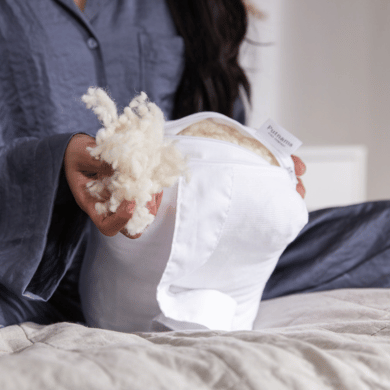
Der Leitfaden für ein Nickerchen: Wie Sie neue Energie tanken, ohne Ihren Schlaf zu ruinieren
Ein Nickerchen kann Ihren Alltag grundlegend verändern und Ihnen Vorteile wie mehr Energie, bessere Konzentration und eine gehobene Stimmung bieten. Allerdings ist nicht jedes Nickerchen gleich effektiv. Falsch ausgeführt, kann es Sie benommen zurücklassen oder Ihren Nachtschlaf stören. Dieser kurze Leitfaden gibt Ihnen praktische Tipps für ein effektives Nickerchen, darunter die optimale Dauer, den idealen Zeitpunkt, die beste Umgebung und Tipps für eine gesunde Haltung.
Möchten Sie erfrischt und voller Energie aufwachen?
Lesen Sie weiter, um alles zu erfahren, was Sie über die Erstellung Ihres perfekten Nickerchenplans wissen müssen.
Die Wissenschaft hinter einem guten Nickerchen
Ihr natürlicher Schlafrhythmus spielt eine entscheidende Rolle dafür, wie Sie sich während und nach Ihrem Nickerchen fühlen. Der Schlaf verläuft in Phasen, darunter leichter Schlaf (Phase 1 und 2), Tiefschlaf und REM-Schlaf (Schlaf mit schnellen Augenbewegungen).
Kurze Nickerchen von unter 30 Minuten halten Sie in den leichten Schlafphasen und helfen Ihnen so, erfrischt aufzuwachen, ohne in die Benommenheit des Tiefschlafs zu fallen.
Studien zeigen, dass selbst ein kurzes Nickerchen erhebliche Vorteile bieten kann. Zum Beispiel:
- Eine NASA-Studie ergab, dass ein 26-minütiges Nickerchen die Wachsamkeit um 54 % und die Leistungsfähigkeit um 34 % bei Piloten verbesserte.
- Die Mayo-Klinik hebt hervor, wie bereits kurze Nickerchen von 10 bis 20 Minuten die geistige Klarheit verbessern können, ohne dass man desorientiert wird.
Siehe auch – NASA: Die Vorteile eines Nickerchens für die Sicherheit & Wie schnell kann das Gehirn aufwachen?
Aus dem Schlaf?
Das Verständnis des eigenen zirkadianen Rhythmus, der biologischen Uhr, die Schlaf und Wachsein reguliert, kann Nickerchen effektiver machen. Die meisten Menschen erleben zwischen 13 und 15 Uhr einen natürlichen Energieabfall; dies ist daher die beste Tageszeit für ein Nickerchen .
Wie lange sollte ein Nickerchen wirklich dauern?
Die optimale Dauer eines Nickerchens hängt von Ihren Zielen und Ihrem bestehenden Schlafrhythmus ab.
Hier ist eine Übersicht über gängige Nickerchendauern und deren Vorteile:
Das Powernap (10-20 Minuten)
A Ein Powernap ist ideal, wenn Sie sich erholt und nicht müde fühlen möchten. In den leichten Schlafphasen bleiben Sie fit und konzentriert auf den Tag und bereit für den Rest des Tages. Perfekt für Berufstätige und Eltern, die einen kurzen Energieschub brauchen – diese kurze Nickerchenlänge steigert Ihre Produktivität.
Das Erholungsschläfchen (30-60 Minuten)
Bei Schlafmangel kann ein etwas längeres Nickerchen helfen, die Energiereserven wieder aufzufüllen. Ein Erholungsschlaf ist besonders nützlich, um verlorenen Schlaf nachzuholen, erfordert aber Vorsicht. Wacht man in den tieferen Schlafphasen auf, kann es zu „Schlafträgheit“ kommen – einem benommenen, desorientierten Gefühl, das einige Zeit anhält.
Ein vollständiger Schlafzyklus (90 Minuten)
Diese Art von Nickerchen ermöglicht es Ihrem Körper, einen vollständigen Schlafzyklus inklusive REM-Schlaf zu durchlaufen, was Kreativität und Gedächtniskonsolidierung fördert. Es empfiehlt sich, diese Art von Nickerchen nur in seltenen Fällen einzulegen, wenn Sie sich anschließend ausreichend Zeit zur vollständigen Erholung nehmen können.
Profi-Tipp:
Das Stellen eines Weckers ist entscheidend, um die gewünschte Nickerchendauer einzuhalten. Selbst fünf zusätzliche Minuten beim Übergang in den Tiefschlaf können zu Benommenheit beim Aufwachen führen.
Siehe auch – Kann man wirklich Schlaf nachholen? Der Mythos vom Ausschlafen am Wochenende.
Wann man ein Nickerchen machen sollte, um maximale Energie zu haben
Wann ist die beste Tageszeit für ein Nickerchen?
Der richtige Zeitpunkt für ein Nickerchen ist genauso wichtig wie dessen Dauer. Der frühe Nachmittag , typischerweise zwischen 13 und 15 Uhr, passt gut zum natürlichen Nachmittagstief des Körpers. Dieser Zeitpunkt unterstützt den zirkadianen Rhythmus und sorgt dafür, dass das Nickerchen nicht mit dem Zubettgehen kollidiert.
Ein Nickerchen am späten Nachmittag oder Abend, insbesondere nach 16 Uhr, kann das Einschlafen erschweren und den Schlafrhythmus stören. Es gibt zwar keine festen Regeln für Nickerchen, aber die Regel, nach 16 Uhr nicht mehr zu schlafen, ist eine der wichtigsten Richtlinien für ein Nickerchen, das den Nachtschlaf nicht beeinträchtigt.
Wussten Sie schon, dass Nickerchen in der Familie liegen könnten? – Genetische Faktoren für das Nickerchen am Tag und seine Auswirkungen auf die kardiometabolische Gesundheit
Die Rolle der Körperhaltung bei der Erholung nach einem Nickerchen
Die richtige Haltung beim Nickerchen kann entscheidend dafür sein, wie erfrischt man sich nach dem Aufwachen fühlt. Unbehagen oder eine falsche Ausrichtung können ein ansonsten perfektes Nickerchen ruinieren. Schlafen in ungünstigen Positionen, insbesondere wenn man zusammengesunken auf einem Stuhl sitzt oder den Kopf auf einem Schreibtisch ablegt, kann zu Muskelverspannungen führen.
Hier sind fünf praktische Tipps für eine bessere Körperhaltung beim Nickerchen :
- Lagern Sie Ihren Oberkörper höher: Ein ergonomisches Keilkissen kann Ihren Kopf leicht anheben und so die Wahrscheinlichkeit verringern, mit Nackensteife aufzuwachen.
- Stützen Sie Ihren unteren Rücken: Wenn Sie an Ihrem Schreibtisch oder Stuhl ein Nickerchen machen, kann ein Bürokissen mit Lendenwirbelstütze dazu beitragen, die richtige Ausrichtung der Wirbelsäule beizubehalten.
- Richten Sie Ihren Nacken aus: Ein Reisekissen kann Nackenverspannungen vorbeugen, indem es Ihren Kopf aufrecht hält.
- Vermeiden Sie es, Ihren Körper einzuengen: Flaches Liegen kann manchmal zu unnatürlichen Nackenpositionen führen. Eine leicht geneigte, halb zurückgelehnte Haltung ist oft erholsamer.
- Komfort überall: Wenn Sie unterwegs sind, sorgt ein multifunktionales Kissen wie das Reisekissen von Putnams dafür, dass Sie auch beim Nickerchen unterwegs eine gute Haltung beibehalten können.
Hilfsmittel für ein komfortableres Nickerchen
Die richtige Umgebung kann ein gewöhnliches Nickerchen in ein erholsames Erlebnis verwandeln. Faktoren wie Lärm, Temperatur und Lichteinfall spielen dabei eine wichtige Rolle. Beachten Sie diese Punkte für eine gesunde Nickerchenroutine :
1. Putnams Keilkissen
Diese ergonomischen Keilkissen heben Ihren Oberkörper an, sorgen so für freie Atemwege und weniger Beschwerden. Sie eignen sich ideal für ein kurzes Nickerchen zu Hause, insbesondere auf dem Bett oder Sofa.
2. Bürokissen für Arbeitspausen
Für Berufstätige im Homeoffice oder im Büro bieten die Lendenkissen von Putnams optimale Unterstützung für eine korrekte Rückenhaltung bei kurzen Nickerchen am Schreibtisch. So lässt sich das Sitzen leichter entspannen und die Wirbelsäule wird entlastet.
3. Reiseunterstützung für Nickerchen unterwegs
Wenn Sie häufig reisen, sollten Sie die Vielseitigkeit der Reisestützen von Putnams in Betracht ziehen. Sie bieten optimale Nacken- und Lendenwirbelstütze und verhindern unbequeme Positionen, egal wo Sie ein Nickerchen machen.
4. Verdunkelter Raum
Verdunkelungsvorhänge oder eine Schlafmaske können die Lichteinwirkung minimieren und Ihnen so helfen, schneller einzuschlafen und die gewünschte Schlafdauer durchzuschlafen.
5. Weißes-Rauschen-Maschinen
Umgebungsgeräusche können Ihren Schlaf schnell stören. Ein Gerät für weißes Rauschen oder geräuschunterdrückende Kopfhörer können Ablenkungen ausblenden und eine ruhige, schlaffördernde Atmosphäre schaffen.
6. Temperaturregelung
Sorgen Sie für eine kühle Umgebung beim Nickerchen. Studien zeigen, dass eine ideale Temperatur von etwa 18–22 °C das Einschlafen erleichtert.
Siehe auch – Verbessern Sie Ihr Reiseerlebnis mit Sitzkeilen und Reiseauflagen
Wie man ein Nickerchen macht, ohne sich benommen zu fühlen
Selbst bei optimaler Nickerchenlänge kann ein schlecht durchgeführtes Nickerchen zu Benommenheit führen. Befolgen Sie diese zusätzlichen Tipps, um den gefürchteten Nebel nach dem Nickerchen zu vermeiden:
- Um Tiefschlafphasen und damit verbundene Schlafträgheit zu vermeiden, sollten Sie möglichst kurze Nickerchen machen.
- Vermeiden Sie Bildschirmzeit unmittelbar vor Ihrem Nickerchen. Die Belastung durch blaues Licht von Geräten kann Ihr Einschlafen erschweren.
- Machen Sie direkt nach dem Aufwachen einen kurzen Spaziergang oder spritzen Sie sich kaltes Wasser ins Gesicht, um sich schneller wieder energiegeladen zu fühlen.
Wie man ein Nickerchen macht, ohne den Nachtschlaf zu ruinieren
Ein Nickerchen kann, wenn es strategisch eingesetzt wird, den Nachtschlaf ergänzen, anstatt ihn zu ersetzen. So gelingt ein Nickerchen, ohne den Nachtschlaf zu beeinträchtigen:
- Nickerchen sollten nicht länger als 30 Minuten dauern, insbesondere wenn Sie bereits ausreichend geschlafen haben.
- Um Störungen des Schlaf-Wach-Rhythmus zu vermeiden, sollten Sie nach 16 Uhr keinen Mittagsschlaf machen.
- Halten Sie Ihre gewohnte Schlafenszeit ein, auch wenn Ihnen das Nickerchen neue Energie gibt.
Siehe auch – Der ultimative Leitfaden für besseren Schlaf mit der Putnams Comfort-Produktreihe
...Ich ruhe mich nur kurz aus.
Ein Nickerchen kann, richtig angewendet, ein wirkungsvolles Mittel sein.
Durch die Anpassung von Dauer, Zeitpunkt und Haltung beim Nickerchen können Sie die energiespendende Wirkung genießen, ohne Ihren Nachtschlaf zu beeinträchtigen. Ob Sie ein vielbeschäftigter Berufstätiger, ein erschöpfter Elternteil oder einfach jemand sind, der nachmittags einen Energieschub braucht – die richtigen Hilfsmittel, wie z. B. Keilkissen , Bürokissen und Reisekissen von Putnams, können den entscheidenden Unterschied machen.
Übernehmen Sie noch heute die Kontrolle über Ihr Energieniveau, indem Sie eine gesunde Nickerchenroutine entwickeln , die Sie erfrischt, energiegeladen und bereit für den Tag macht.
„Beginnen wir mit einem kurzen Nickerchen oder zwei.“ – A. A. Milne

















Hinterlassen Sie einen Kommentar